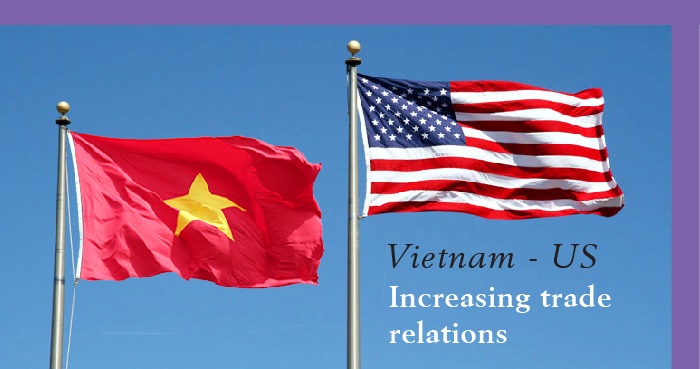Vietnam – US Increasing Trade Relations

By: Koushan Das
In May 2017, Vietnam and the US signed business deals worth US$8 billion. The majority of the deals were for aircraft engines and development of power generation capabilities, along with hospitality, science and technology, academia and energy. The deals are predicted to create more than 23,000 American jobs and help in reducing the US trade deficit with Vietnam, which stood at almost US$32 billion in 2016. To sustain its export-driven economy and minimize the effects of US withdrawal from the TPP, Vietnam is pushing for increased trade relations with the US, its largest export market.
 RELATED: Pre-Investment Advisory Services from Dezan Shira & Associates
RELATED: Pre-Investment Advisory Services from Dezan Shira & Associates
The history of US-Vietnam trade relations
Since the US-Vietnam Bilateral Trade Agreement (BTA) in 2001, which extended MFN status to the Vietnamese market, trade and US investments in Vietnam have increased dramatically. Major US exports to Vietnam include agricultural products, machinery, yarn/fabric, and vehicles while imports include apparel, footwear, furniture and bedding, agricultural products, seafood, and electrical machinery.
Trade between the two has been growing by 20 percent annually since 2001, with 2016 trade reaching US$47 billion – 33.5 times higher than 2001 figures. Vietnam is US’s 16th largest trade partner and the fastest-growing market for US exports. Trade between the two nations is however tipped in Vietnam’s favor. In 2016 and 2015, Vietnam’s trade surplus stood at US$32 billion and US$31 billion respectively.
In the first four months of 2017, US accounted for 20 percent of Vietnam’s exports, an increase of 8.7 percent from the same period last year. Major export items included textile-garment, footwear, computers, seafood, farm products, timber and timber products, electronics and components.
Deals signed in 2017
In the recent exchange, deals worth U$8 billion were signed between the two countries. General Electric signed its largest single combined sale with the country worth US$5.58 billion for power generation, aircraft engines, and services. The agreement includes 20 jet engines made by CFM International, a joint venture of GE and Safran for VietJet Aviation. Also included is a 12-year engine service contract for 100 Boeing 737 MAX aircraft that VietJet has ordered. VietJet also signed a US$1 billion deal with GE Capital Aviation Services for aircraft financing.
In the power sector, GE signed a memorandum of understanding to build two 750-megawatt gas-fired turbine power plants in conjunction with state energy group PetroVietnam. Also included in the deal is a joint development agreement for an 800-megawatt wind power facility. Caterpillar and its Vietnam subsidiary agreed to provide generator management technology for more than 100 generators in Vietnam.The remaining deals focused on hospitality, science and technology, academia and energy.
TPP without the US
Vietnam would have been one of the major beneficiaries of the original TPP’s reduced tariffs. TPP including US would have led to an increase in US investments and help Vietnam position itself as a viable alternative to China for low-cost manufacturing. However, with the new US administration favoring bilateral trade deals rather than multilateral, few TPP member countries are pushing to revive the agreement without the US.
Without the US, the scale and effect of the renewed agreement will be diminished considerably as US accounted for almost 60 percent of the group’s total gross domestic product (GDP). According to recent data, the renewed TPP without the US, also called TPP11, would reduce trade amongst members to only a quarter of the original deal and reduce the market size by almost half.
Vietnam had implemented numerous changes in state-owned enterprises and deregulated key sectors such as finance, telecommunications, and retail in anticipation of gaining access to the US market. Even without the US, Vietnam believes that a renegotiated TPP will be feasible as TPP focused not only on market access, but also on reforms in labor, labor, transparency, IP protection, and anticorruption, which would help modernize its economy. The country will also benefit from increased market access in new members and a deeper integration in global supply chains. TPP11 will allow member states reduce their dependence on China, which backs the Regional Comprehensive Economic Partnership (RCEP), which is a 16-nation trade pact that includes the Association of Southeast Asian Nations (ASEAN), along with China, Australia, India, Japan, South Korea, and New Zealand.
 RELATED: TPP is Dead, What’s Next for Vietnam?
RELATED: TPP is Dead, What’s Next for Vietnam?
The Future of EU and US trade relations with Vietnam
US market
The US’s withdrawal from the TPP has had no substantial effect on the trade between the two nations. Trade has been growing by almost 20 percent since 2001 and industry analysts believe the trend will continue. Vietnam’s exports to the US in 2017 are predicted to reach US$45 billion and over US$65 billion by 2020.
However, US have been trying to narrow its growing trade deficit and increase exports to Vietnam. In 2016, the deficit stood at US$32 billion, up from US$7 billion, only a decade earlier. The deficit highlights the importance of Vietnamese high-tech exports such as electronics and semiconductors along with traditional exports such as footwear, apparel, furniture, and textiles.
EU market
In 2016, EU-Vietnam trade stood at over US$47.7 billion, with US$37.2 billion in imports from Vietnam into the EU and US$10.5 billion in exports from the EU to Vietnam. To further increase trade relations, both parties have signed the Vietnam-EU Free Trade Agreement (EVFTA), to be in effect from 2018.
Once in effect, it will provide Vietnam access to a potential market of 500 million people accounting for almost a quarter of the global GDP. In Vietnam, real wages of skilled laborers and common workers are expected to rise by 12-13 percent. Reduced and eliminated tariffs will increase the GDP annually by 0.5 percent annually, while exports are expected to grow annually by 4-6 percent. Major Vietnamese exports to EU such as textile, clothing, and footwear are expected to more than double by 2020 because of the FTA.
However, the benefits of the agreement will take time to be realized, as certain products that are sensitive for EU producers, particularly in the textile apparel and footwear sectors, will have longer liberalization periods of up to seven years.
Trade outlook
Trade experts predict exports to grow over 13 percent in 2017 driven by acceleration in global trade and higher import of raw materials and electronic parts. Largest export markets will continue to be US, EU, China, and Japan accounting for 22 percent, 18 percent, 12 percent, and 8 percent respectively of total exports.
|
Vietnam Briefing is published by Asia Briefing, a subsidiary of Dezan Shira & Associates. We produce material for foreign investors throughout Eurasia, including ASEAN, China, India, Indonesia, Russia & the Silk Road. For editorial matters please contact us here and for a complimentary subscription to our products, please click here. Dezan Shira & Associates provide business intelligence, due diligence, legal, tax and advisory services throughout the Vietnam and the Asian region. We maintain offices in Hanoi and Ho Chi Minh City, as well as throughout China, South-East Asia, India, and Russia. For assistance with investments into Vietnam please contact us at vietnam@dezshira.com or visit us at www.dezshira.com
|
![]()
 Dezan Shira & Associates Brochure
Dezan Shira & Associates Brochure
Dezan Shira & Associates is a pan-Asia, multi-disciplinary professional services firm, providing legal, tax and operational advisory to international corporate investors. Operational throughout China, ASEAN and India, our mission is to guide foreign companies through Asia’s complex regulatory environment and assist them with all aspects of establishing, maintaining and growing their business operations in the region. This brochure provides an overview of the services and expertise Dezan Shira & Associates can provide.
 An Introduction to Doing Business in Vietnam 2017
An Introduction to Doing Business in Vietnam 2017
An Introduction to Doing Business in Vietnam 2017 will provide readers with an overview of the fundamentals of investing and conducting business in Vietnam. Compiled by Dezan Shira & Associates, a specialist foreign direct investment practice, this guide explains the basics of company establishment, annual compliance, taxation, human resources, payroll, and social insurance in this dynamic country.
 Managing Contracts and Severance in Vietnam
Managing Contracts and Severance in Vietnam
In this issue of Vietnam Briefing, we discuss the prevailing state of labor pools in Vietnam and outline key considerations for those seeking to staff and retain workers in the country. We highlight the increasing demand for skilled labor, provide in depth coverage of existing contract options, and showcase severance liabilities that may arise if workers or employers choose to terminate their contracts.
- Previous Article Come aprire un conto bancario in valuta estera in Vietnam
- Next Article Vietnam Climbs 12 Places in Global Innovation Index
































